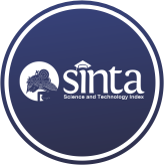Optimalisasi Database Mysql Pada Sistem Perancangan Sistem Housekeeping Transaction History Dengan Pentaho Data Integration
(1) Universitas Kristen Satya Wacana, Indonesia
(2) Universitas Kristen Satya Wacana, Indonesia
(*) Corresponding Author
Abstract
Full Text:
PDFReferences
I. P. W. Prasetia and I. N. H. Kurniawan, “Implementasi ETL (Extract, Transform, Load) pada Data warehouse Penjualan Menggunakan Tools Pentaho,” TIERS Inf. Technol. J., vol. 2, no. 1, pp. 1–8, 2021, doi: 10.38043/tiers.v2i1.2844.
M. R. Hartani and I. B. M. Mahendra, “Implementasi Data Warehouse Menggunakan Pentaho BI di Hartaning House Homestay,” JELIKU (Jurnal Elektron. Ilmu Komput. Udayana), vol. 10, no. 1, p. 153, 2021, doi: 10.24843/jlk.2021.v10.i01.p18.
W. P. N. Witjaksono, R Wahjoe., Wiyogo Mardiyanto., “Perancangan Aplikasi Business Intelligence Pada Sistem Informasi Distribusi PT Pertamina Lubricant Menggunakan Pentaho,” J. Rekayasa Sist. Ind., vol. 2, no. 2, pp. 12–18, 2015.
D. Putri, Pipit M., Gunawan, Syam., Shubuh, “Perancangan Data warehouse dan Penerapannya pada Sistem Informasi Penjualan Menggunakan Tools Pentahoo dan Tableau.,” J. Inform. Komputasi, vol. 12, no. 1, pp. 15–21, 2018.
A. Hidayat, Luky., Permanasari, Adhistya Erna., “Perancangan Data warehouse E-Procurement Pada Instansi Pemerintahan,” Semin. Nas. Inov. Dan Apl. Teknol. Di Ind., vol. 3, no. 1, pp. 31–36, 2017.
S. Darudiato, “Perancangan Data warehouse Penjualan untuk Mendukung Kebutuhan Informasi Eksekutif Cemerlang Skin Care,” Semin. Nas. Inform. 2010, pp. 350–359, 2010.
S. N. W. Sumartini and M. N. M. Lisma, “Extract Transform Loading Data Absensi STMIK STIKOM Indonesia Menggunakan Pentaho,” J. MATRIK, vol. 19, no. 2, pp. 273–281, 2020.
K. Syahputri, M. Irwan, and P. Nasution, “Peran Database Dalam Sistem Informasi Manajemen,” J. Akunt. Keuang. dan Bisnis, vol. 1, no. 2, pp. 54–58, 2023, [Online]. Available: https://jurnal.ittc.web.id/index.php/jakbs/article/view/36
P. A. Jusia, “Analisis komparasi pemodelan algoritma decision tree menggunakan metode particle swarm optimization dan metode adaboost untuk prediksi awal penyakit jantung.,” Semin. Nas. Sist. Inf., pp. 1048–1056, 2018.
S. S. Lubis and B. Hendrik, “Implementasi Data Mining Pengelompokan Data Penjualan Berdasarkan Pembelian Dengan Menggunakan Algoritma K-Means Pada UD.Martua,” J. Inf. Sysem Educ. Dev., vol. 1, no. 3, pp. 36–41, 2023, [Online]. Available: https://journal.widyakarya.ac.id/index.php/jusiik-widyakarya/article/view/1531%0Ahttps://journal.widyakarya.ac.id/index.php/jusiik-widyakarya/article/download/1531/1563
P. A. Jusia, “Face Recognition Menggunakan Metode Algoritma Viola Jones Dalam Penerapan Computer Vision.,” J. Ilm. Media Process., vol. 11, no. 1, pp. 663–675, 2016.
J. P. Jiawei Han, Micheline Kamber, “Data Mining: Concepts and Techniques (The Morgan Kaufmann Series in Data Management Systems),” 2011.
P. Alam Jusia, F. Muhammad Irfan, and S. Dinamika Bangsa Jambi Jl Jend Sudirman Thehok Jambi, “Clustering Data Untuk Rekomendasi Penentuan Jurusan Perguruan Tinggi Menggunakan Metode K-Means,” J. IKRA-ITH Inform., vol. 3, no. 3, p. 75, 2019.
F. Handayani, “Aplikasi Aplikasi Data Mining Menggunakan Algoritma K-Means Clustering untuk Mengelompokan Mahasiswa Berdasarkan Gaya Belajar,” J. Teknol. dan Inf., vol. 12, no. 1, pp. 46–63, 2022, doi: 10.34010/jati.v12i1.6733.
B. K. Easterita, I. Arwani, and D. E. Ratnawati, “Pengembangan Data Warehouse dan Online Analytical Processing (OLAP) untuk Data Artikel pada Jurnal Teknologi Informasi dan Ilmu Komputer (JTIIK),” J. Sist. Informasi, Teknol. Informasi, dan Edukasi Sist. Informasi, vol. 1, no. 1, pp. 12–22, 2020.
R. Abdul Ghani and R. Kurniawan, “Implementasi Extract, Transform, Load Process Pada Perancangan Data Warehouse Terkait Kualitas Pendidikan Di Kabupaten Serang,” JATI (Jurnal Mhs. Tek. Inform., vol. 8, no. 2, pp. 2083–2090, 2024, doi: 10.36040/jati.v8i2.9081.
S. C. M. Souibgui, F. Atigui, S. Zammali and and S. Ben Yahia, “Data quality in ETL process: A preliminary study,” Procedia Comput, vol. 159, pp. 676–687, 2019.
J. A. O’Brien and G. M. Marakas, Management Information Systems. McGraw- Hill Education, 2016.
I. E. Gordon, “The HITRAN2020 molecular spectroscopic database,” J. Quant. Spectrosc. Radiat. Transf, vol. 227, 2022.
T. Connolly and C. Begg, A Practical Approach to Design, Implementation, and Management. Pearson Education, 2014.
DOI: https://doi.org/10.30645/kesatria.v6i1.542
DOI (PDF): https://doi.org/10.30645/kesatria.v6i1.542.g537
Refbacks
- There are currently no refbacks.
Published Papers Indexed/Abstracted By:














